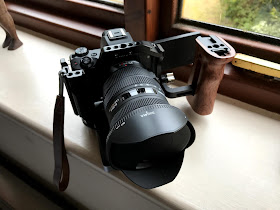When you use a 10mm adapted (using the Canon EF > M adapter) lens on the M50 (The native EOS M 11-22mm would give similar results) you get the 35mm equivalent of a 16mm images for still photographs. However when you switch to 4K video this reduces to 26mm.
When putting the Sigma 10mm lens I used via the Viltrox 0.71x adapter on the M50, you get a heavily vignetted still image. This is because these 'Speedbooster' adapters are meant for use with full-frame lenses. Using this APS-C lens means that the adapter just shows up the 'dead' area of the lens. However, switching to 4K video with it's extra crop gets rid of all that vignetting and in 35mm terms gives a 10 x 0.71 x 2.56 = 18.18mm equivalent. This is a much wider option and allows for 4K shooting with a genuine wide-angle look. There is also the bonus that since the adapter lets more light into the camera, instead of the Sigma 10-20mm zoom showing f/3.5 as it's maximum adapter, it shows f/2.5. So a stop more light.
I should point out here that Canon APS-C lenses won't work with the Viltrox adapter or the Metabones version. For reasons best known to themselves Canon have made their APS-C lenses deeper than their FF lenses, so they won't fit the adapter. However, Sigma use the standard EF mount on both their FF AND APS-C lenses, so they fit perfectly.
The majority of the criticisms of the M50 4K video is this 2.56x crop factor. (This figure includes the 1.6x Canon APS-C crop and relates to a 35mm / Full Frame sensor) Now it would be nice if Canon could actually come out with a non cropped 4K video option. As yet they haven't done that on any of their cameras, which considering their experience with video is somewhat surprising. However, while the above isn't an ideal solution, it does work, though with extra expense. Incidentally using the 11-22mm EOS M zoom lens at 11mm you would get the 35mm equivalent of a 28mm lens. OK, but hardly serious wide-angle territory.
Three further things. Firstly the Sigma 10-22mm f/3.5 has no IS and since there is no IBIS in the M50, hand holding can be shaky. However in the video below I used the stabilisation in iMovie and as you can see it worked well.
Secondly, I can't leave this without some mention of the appalling AF in 4K video on the M50. If indeed it can be called AF. It just seems to move back and forth with a mind of it's own. Servo AF is hardly any better, MF peaking is just a coloured mess in the viewfinder and enlarging the image is also unsatisfactory due to the pretty average EVF. So what do I do? Well I move the mode dial to M which is next to the movie icon, use the AF on the camera and then switch back to the movie mode without changing anything. It does then lock on. It's fiddly, but at least it's quick and accurate. There is absolutely no excuse for this and Canon should be ashamed of themselves for such a shoddy implementation.
Thirdly, the outfit that I have includes a power pack fitted to the bottom of the camera. This gets round the poor battery life of the camera. However this means that I can't get access to the SD card. However, one thing I would recommend is the Image Transfer Utility. After setting up all I have to do is open the utility and the images transfer automatically to my computer. It's simple and it works.
CONCLUSION
The final point about the autofocus in 4K video does spoil, what in quality terms, is a pretty decent little camera for video. These issues are all the more irritating because the 4K output is actually very good, considering the crop factor involved. Of course if you want to use HD for video then there are fewer problems. It seems crazy to put decent 4K video in a camera and then attempt to sabotage it. The commonly held view is that Canon do this to protect their dedicated video camera range. But then potential buyers for the M50 would have little interest in buying one of those, just as video professionals shooting for film and TV would have little interest in buying an M50. There is clearly some muddled thinking going on here and I can see no reason why Canon should choose to 'cripple' a camera in this way. Apparently the Canon Connect App makes focusing in 4K easier, but shooting hand held means that I probably need 3 hands to so that?
The rig I've put together does work and achieves the objective of shooting genuine wide angle 4K footage with the M50. And after a lot of messing about I've got a system which is relatively easy to use. It shouldn't be this way, but it is possible to get decent results with a relatively small expense.
Finally here's a short sample 4K video I shot yesterday.









